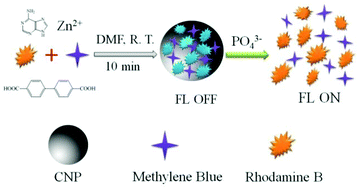A turn-on coordination nanoparticle-based fluorescent probe for phosphate in human serum†
Abstract
Coordination nanoparticles (CNPs) are becoming attractive platforms for chemical sensing applications because their unique adjustable properties offer the opportunity to design various luminescent nanoprobes. Here, we present a CNP-based fluorescent nanoprobe, in which fluorophores (rhodamine B, RB) and quenchers (methylene blue, MB) were spontaneously enfolded by coordination networks self-assembled of adenine, biphenyl-4,4′-dicarboxylic acid (BDA) and zinc ions. The aggregation of fluorophores and quenchers in CNPs resulted in a quenched state fluorescence of RB. RB and MB could be released from CNPs in the presence of phosphate, which triggered the fluorescence of RB. On the basis of recognition-driven disassembly principle, a novel turn-on fluorescent probe for the determination of PO43− with a wide response range (0.5–50 μM) has been successfully applied in the detection of phosphate in human serum samples. This work not only develops a probe for phosphate but also provides a general strategy for designing nanoprobes or nanocarriers towards various targets by altering organic linkers or metal ions.


 Please wait while we load your content...
Please wait while we load your content...